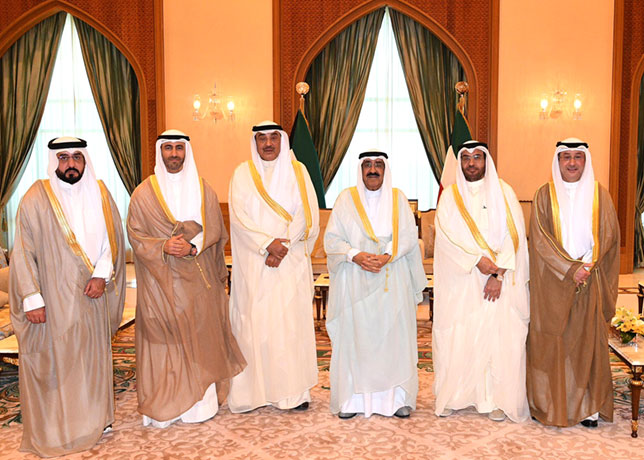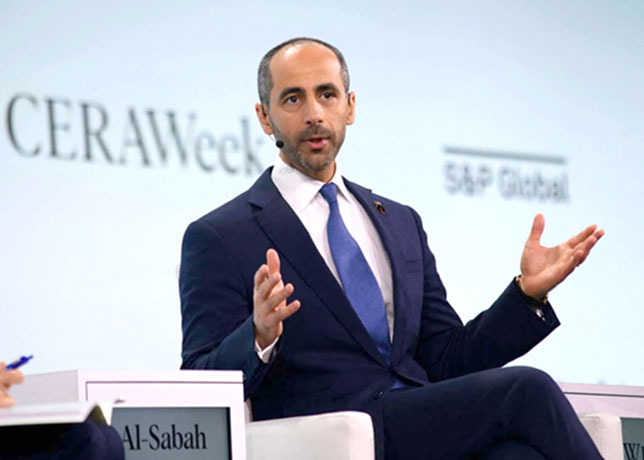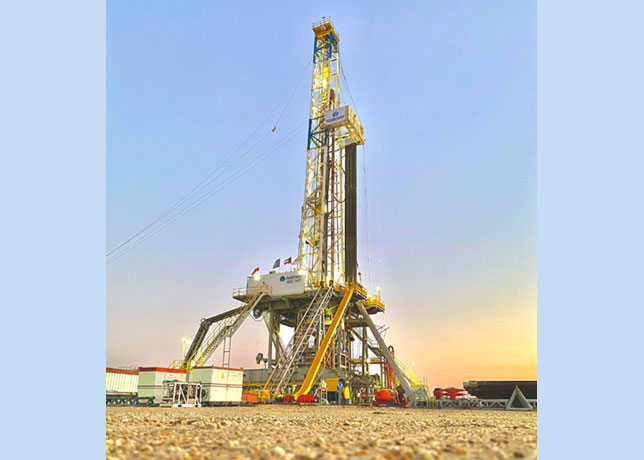
 Sheikh Nawaf Al Sabah speaking at the CERAWeek conference. Image courtesy: CERAWeek
Sheikh Nawaf Al Sabah speaking at the CERAWeek conference. Image courtesy: CERAWeek
Kuwait Petroleum Corporation plans to spend $300 billion by 2040 to sustain production capacity and feels these investments are crucial for maintaining and increasing output in a world where energy demand is expected to outpace population growth, even amid the ongoing energy transition
As the world continues to evolve towards more sustainable energy solutions, Kuwait Petroleum Corporation (KPC) is steadfast in its commitment to increasing production capacity and maintaining its role as a reliable and efficient energy provider.
The company's significant investments and strategic initiatives underscore its belief in the enduring importance of oil in the global energy mix, while simultaneously embracing innovative approaches to renewable energy and national development.
KPC plans to invest approximately $300 billion by 2040 to sustain production capacity and manage natural declines, said Nawaf Al-Sabah, Deputy Chairman and Chief Executive Officer of KPC, speaking to Daniel Yergin, Vice Chairman, S&P Global, at the CERAweek 2024 in Houston.
Al-Sabah outlined the company's ambitious plans to increase its production capacity to 4 million barrels per day by 2035 and the crucial question of energy transition in the interview.
Investments are crucial for maintaining and increasing output in a world where energy demand is expected to outpace population growth and this strategy is grounded in a firm belief in the continued global demand for oil, even amid the ongoing energy transition, he said.
Current Capacity and Future Goals
KPC currently boasts a production capacity of 3 million barrels per day, though actual production is often lower due to OPEC quotas. Al-Sabah emphasised the necessity of expanding capacity to meet future demand, which he predicts will persist despite the shift towards renewable energy sources.
"We're at 3 million barrels a day of production capacity today, producing less due to OPEC allocations," Al-Sabah explained. "Our goal is to reach 4 million barrels a day by 2035 because we see demand increasing throughout this energy transition."
Low-Cost, Low-Carbon Advantage
 |
KPC employs about 23,000 people |
One of KPC's competitive advantages is its low production costs and carbon intensity. Al-Sabah highlighted that Kuwait's oil lifting costs are below $10 per barrel, and the carbon footprint of their production is among the lowest globally.
"Our barrels of production will be the most desired within the energy mix," he asserted. "We start with low cost and low carbon intensity, which allows us to fulfill the energy trilemma of reliability and sustainability."
Global Energy Demand
Al-Sabah provided a broader context for KPC's strategy, noting that global energy demand is set to increase faster than population growth, particularly in the Global South. "It's only fair to allow countries experiencing energy poverty to exploit their natural resources efficiently and cleanly and not have them pay for the excesses of industrialized nations," Al-Sabah said. "This will significantly contribute to the future energy demand."
Kuwait's Innovative Approach
Al-Sabah also discussed KPC's innovative approaches to its operations and market strategies. Emphasizing a partnership mentality with customers, KPC sees mutual growth as a cornerstone of its business model.
"In Kuwait, we recognize that we are a national oil company with an international presence," he said. "We've pioneered retail downstream networks in Europe, strategically complementing our home business in Kuwait."
This forward-thinking approach ensures that KPC remains a key player in the global energy market, poised to meet future challenges and opportunities as the world navigates its energy transition.
National Development and Diversification
 |
A crude distillation unit at a KPC facility |
KPC's strategy aligns with Kuwait's broader national development goals. Al-Sabah emphasized the importance of reducing the country's dependence on oil revenue, which currently accounts for about 90% of government income and 50% of GDP.
"Our new leadership is visionary, moving Kuwait towards a more diversified economy," Al-Sabah said. "Our Prime Minister, who wrote his Harvard dissertation on avoiding the resource curse, is putting theory into practice."
KPC is also leveraging AI and digital technology to enhance operations. "We're deploying AI in our digital oil field to ensure predictive, efficient operations," he added.
Partnerships and Future Models
KPC is looking to innovate through partnerships with international oil companies. "We're moving offshore for the first time and anticipate discovering new fields," Al-Sabah noted. "We're exploring new models of collaboration to bring in international expertise for oil production and power generation."
KPC plans to involve both local and international investors in developing solar power projects, potentially creating independent power producers (IPPs) to achieve their ambitious renewable energy goals.
In a progressive move towards sustainability, KPC is actively pushing for electrification and renewable energy to reduce its impact on the national grid and pave the way for green hydrogen production. This initiative, driven by the enthusiasm and support of KPC's youthful workforce, marks a significant step in the company's journey toward a greener future.
Employee Engagement and Innovation
KPC, which employs around 23,000 people, has established an effective feedback mechanism to gather innovative ideas from its staff. This inclusive approach has been crucial in shaping the company's strategic initiatives, particularly in the realm of electrification and renewable energy.
"One of the things we've been pushing internally in Kuwait is electrification, heavily supported by the youth in our system," said Al-Sabah. "We're working towards lowering the burden that the oil sector places on the national grid and creating renewable power to run our production and foster green hydrogen opportunities."
Harnessing Natural Resources
Kuwait is endowed with abundant hydrocarbon resources and plentiful sunlight, making it an ideal location for solar energy projects. In the past, the efficiency of solar panels was hampered by dust, which reduced their effectiveness by 50% shortly after cleaning. However, advancements in solar technology have now enabled KPC to deploy solar panels more efficiently across its production facilities.
"We've rolled out panels to run electric submersible pumps, and we now have a pilot project where the pumps are almost exclusively powered by solar energy," Al-Sabah explained. "We currently use about 1 GW of electricity, which is approximately 6% of the country's power generation."
Ambitious Solar Projects
KPC has greenlit a project to generate 1 GW of power exclusively from solar energy, with plans to double this capacity. Ultimately, the company aims to increase its solar production capacity to 17 GW.
"Our goal is not to create power for the country but to take ourselves off the grid as much as possible and generate enough solar power to create green hydrogen," Al-Sabah stated. "We want to continue being the world's reliable and clean provider of hydrocarbons while also providing different types of power."
Future of Green Hydrogen
While the market for green hydrogen is still in its nascent stages, KPC is committed to creating this market through continuous investment in solar energy. The first step is ensuring sufficient renewable energy to power its operations, which currently require about 1 GW of power, expected to rise to 4.7 GW by 2040-2050.
"We anticipate a massive increase in electricity usage and power demand to power our operations," Al-Sabah noted. "We aim to meet this demand through solar energy and eventually have enough excess power to create green hydrogen."
Speaking on the results of the fiscal year ending March 31, 2024, he said the company's net profits rose to KD1.45 billion, reflecting the efforts in implementing its strategy to advance the oil sector with innovation, excellence, and teamwork.
In a video message, Al-Sabah said: "We have discovered oil in the Al-Nokhatha offshore field, estimated at 3.2 billion barrels of oil equivalent, equal to three years of Kuwait's total production. This discovery, along with our ongoing work in the Durra field, will significantly expand our operations.
In refining, we successfully operated the Duqm and Al-Zour refineries, increasing local refining capacity to 1.4 million barrels per day.
"Our strategic goal for refining capacity outside Kuwait was achieved with the Duqm refineries in partnership with facilities in Italy and Vietnam. In petrochemicals, we continue to expand globally, seeking acquisitions to add value to Kuwaiti hydrocarbons. Our marketing sector secured a 10-year crude oil sales contract with a key Chinese customer, representing over 10% of our current production," he said.
The company also signed an MoU to store 4 million barrels of Kuwaiti crude in South Korea, ensuring safe and reliable market access in Asia.
Kuwait had announced a new strategy to boost fossil fuel production in October 2023. Under the new strategy, announced by Oil Minister Saad Al Barrak, KPC’s subsidiary KOC will aim to increase oil production capacity to 3.65 million bpd by 2035. This will ensure about $11 billion of additional revenue for the state.
KOC, which accounts for about 90 per cent of Kuwait's oil output, also plans to reach gas production capacity of 1.5 trillion cubic feet per day by 2040. Kuwait's oil reserves are estimated at 100 billion barrels.
KPC will spend $410 billion through 2040 on the strategy, said Bader Al Attar, KPC Managing Director for Planning and Finance. That will be financed from KPC's cash flow, debt and partnerships with other companies.
KPC and its subsidiaries plan to invest $110 billion - out of the $410 billion - to achieve the group's energy transition goals, Al Attar said.
KPC also aims to increase its refining capacity to 1.6 million bpd locally and 425,000 bpd abroad by 2025.
The company's 2050 energy transition strategy aims for carbon neutrality by 2060.










































































